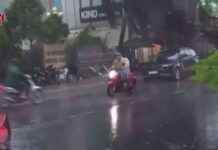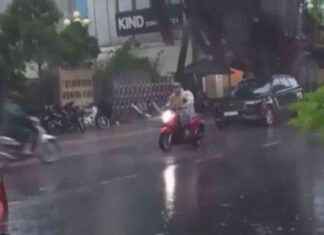builders Luke shows Free on an elderberry Bush, its leaves are red: “Already in the summer you have to colour. A sure sign that the Voles were in it. Otherwise, the leaves were still green.” Save the Bush is probably not.
The Knonauer farmer lives, among other things, by the cultivation of elderberry flowers, supplies Ricola in order. 600 shrubs are in a gently inclined slope; the majority still wear green leaves. About twenty bushes are but the victims of the shear mice. The largest local wild mice eat the roots and can cause massive damage. Up to 130 grams consumed in a single mouse of the day. And where it is particularly comfortable, can live per hectare, quite a few hundred of these rodents. The animals destroy fruit trees, potato fields, vegetable crops, cereals.
For the duration of become
elder Plage, with its shallow roots are particularly susceptible. “A Vole can bring a Bush in a few days time to die off,” says Free. He could grant the rodents, the day of the weeks would be within there. And shortly thereafter, probably also the rare fruit trees, the farmer cultivated on the plot next to the elderberry bushes.
“Since a few years, we get rid of the mice at all.”Luke Free Bauer
Now, voles are in agriculture, while a well-known plague. Usually, however, the Population is subjected to cycles, one Every six, seven years to explode their number, then the Mouse collapses were also rapidly and almost completely. But not anymore, it says Luke Freely: “Since a few years, we get rid of the mice at all.” And it’s not just him, colleagues complained about similar Concerns, says Free.
Luke Free the mice fought Fall with. This he stuck in the earth, so that the mice must pass on its way through your courses. Photo: Dominique Meienberg
Cornel Stutz from agroscope has noticed these changes. Stutz runs the Vole-Radar, a network of observation sites in the whole Mediterranean country. Although there are still regions in which every couple of years, the number of mice explodes suddenly and again in the foreseeable future collapses. In the other, but the mouse varies the density for some years now, much slower and less pronounced.
Why this is so, can not say baby is exactly. What is shown by the observations: Extreme peaks occur, especially in cleared landscapes, which provide spaces for weasels, foxes and birds of prey less life. Where the scenery is more varied, the mouse Population is often constant.
“Some of the farmers, the animals no longer fight, but a calculate harvest losses.”Cornel Stutz, research station agroscope
A further role might play, according to Stutz, the dry summer: “In dry soil, the mice can create less of a good course, and you can spread this less explosively.”
the third possible factor is the growing Size of farms. Anyone who has 50, 60, 70 hectares, which can hardly do so against mice as a farmer with 15 acres. “Some farmers are not fighting the animals, but allow the harvest losses. On fodder crops, the damage areas are better manageable than in orchards.”
Luke Free thirty has to Fall. If necessary, he can and fifty more to borrow. Photo: Dominique Meienberg
Luke-Free investing on average half a day per week to keep the plague in check, the cost he estimated at about 15’000 Swiss francs in the year. He takes us to some of the steel tubes with the lid that protrude a few centimeters out of the earth: mouse traps. He pulls one out of the earth, it consists of a nearly thirty centimeters long pipe with a diffuser at the lower end.
Free of the Traps placed so that the mice on the way to pass through your courses in the Fall. You touch a spring, a second tube whizzes like a Guillotine down. In the ideal case, says Free, is the mouse dead on the spot. Thirty of such Traps that the farmer has, and fifty more he can borrow as needed from the neighbors, so he catches up to a hundred bucks a day.
Sysiphus-work
in Addition, he creates a mouse-carburetor, which hurts him as an organic Farmer: An Engine, the pipes with a hose the exhaust gases in the mouse gears. “Actually, a giant crap,” says Free, “we produce CO2 for nothing, and what else is in the exhaust, you’d rather not know at all. But otherwise it’s not unfortunately, easy.”
It is a Sysiphus-work, because the empty mouse courses are always busy and again: “We start at one end of the operation, and when we come to the other, we can start all over again.”
Caught: The Guillotine in the case has killed this mouse. Photo: Dominique Meienberg
Matthias Wüst, wildlife biologist at Pro Natura, the mouse that carburetor is not like, venom even less. With the exhaust gas pollutants are enriched in the earth. And who’s poisoning the animals, harmful to the predators. Also, he says, without mice it go.
He recommends that affected farmers but, in addition, structures for predators-create perches for Buzzards, colorful, broke, and Asthaufen for weasels and ermine, hedges for the Fox. “Buzzard and ermine eat hundreds of mice in the year,” says Wüst. The biologist offers dedicated courses to the topic.
“Every measure is a two-edged sword is.”Luke Free Bauer
Lukas Free the shoulders, shrugs when he hears about this. Clearly he was trying to promote Fox and ermine, sometimes he sees the predators on his farm. Milan and Buzzards living in some of the large trees next to the orchard. But you have to come, it seems, hardly Eating. Soon new Asthaufen and a wide strip of the herb plants, which will form a connecting corridor between the farm and a nearby conservation area, even more mouse hunters to attract to.
Bauer Lukas Free up to a hundred bucks begins with his Fall of the day. Photo: Dominique Meienberg
“But any measure is a two-edged sword,” says Free. “So the predators can hunt, I wouldn’t have to keep the Grass short which is in relation to the biodiversity optimally. And the Asthaufen and herb corridors not used for the enemies – well, Yes, if you are unlucky, you will be by foxes and Weasels. But the mice themselves.”
Created: 28.10.2019, 17:17 PM








